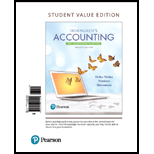
Horngren's Accounting: The Managerial Chapters, Student Value Edition (12th Edition)
12th Edition
ISBN: 9780134491509
Author: MILLER-NOBLES, Tracie L., Mattison, Brenda L., Matsumura, Ella Mae
Publisher: PEARSON
expand_more
expand_more
format_list_bulleted
Concept explainers
Textbook Question
Chapter 18, Problem 10RQ
Explain the difference between a direct cost and an indirect cost.
Expert Solution & Answer
Want to see the full answer?
Check out a sample textbook solution
Students have asked these similar questions
Question 6
I need help solving this financial accounting question with the proper methodology.
Question 8-A
Chapter 18 Solutions
Horngren's Accounting: The Managerial Chapters, Student Value Edition (12th Edition)
Ch. 18 - Prob. 1QCCh. 18 - Prob. 2QCCh. 18 - Dunaway Company reports the following costs for...Ch. 18 - Which of the following is a direct cost of...Ch. 18 - Which of the following is not part of...Ch. 18 - Which of the following accounts does a...Ch. 18 - Questions 7 and 8 use the data that follow....Ch. 18 - Questions 7 and 8 use the data that follow....Ch. 18 - World-class businesses use which of these systems...Ch. 18 - Prob. 10QC
Ch. 18 - What is the primary purpose of managerial...Ch. 18 - List six differences between financial accounting...Ch. 18 - Explain the difference between line positions and...Ch. 18 - Explain the differences between planning,...Ch. 18 - Prob. 5RQCh. 18 - Describe a service company, and give an example.Ch. 18 - Describe a merchandising company, and give an...Ch. 18 - How do manufacturing companies differ from...Ch. 18 - List the three inventory accounts used by...Ch. 18 - Explain the difference between a direct cost and...Ch. 18 - What are the three manufacturing costs for a...Ch. 18 - Give five examples of manufacturing overhead.Ch. 18 - What are prime costs? Conversion costs?Ch. 18 - What are product costs?Ch. 18 - How do period costs differ from product costs?Ch. 18 - How is cost of goods manufactured calculated?Ch. 18 - How does a manufacturing company calculate cost of...Ch. 18 - How does a manufacturing company calculate unit...Ch. 18 - How does a service company calculate unit cost per...Ch. 18 - How does a merchandising company calculate unit...Ch. 18 - Prob. S18.1SECh. 18 - Prob. S18.2SECh. 18 - Distinguishing between direct and indirect costs...Ch. 18 - Computing manufacturing overhead Learning...Ch. 18 - Identifying product costs and period costs...Ch. 18 - Computing cost of goods sold, merchandising...Ch. 18 - Computing cost of goods sold and operating income,...Ch. 18 - Prob. S18.8SECh. 18 - Prob. S18.9SECh. 18 - Prob. S18.10SECh. 18 - S18-11 Matching business trends...Ch. 18 - Prob. S18.12SECh. 18 - Prob. E18.13ECh. 18 - Prob. E18.14ECh. 18 - Prob. E18.15ECh. 18 - Prob. E18.16ECh. 18 - Identifying differences between service,...Ch. 18 - Prob. E18.18ECh. 18 - Computing cost of goods manufactured Learning...Ch. 18 - Prob. E18.20ECh. 18 - Prob. E18.21ECh. 18 - Prob. E18.22ECh. 18 - Prob. E18.23ECh. 18 - Prob. E18.24ECh. 18 - Prob. P18.25APGACh. 18 - Classifying period costs and product costs...Ch. 18 - Calculating cost of goods sold for merchandising...Ch. 18 - Prob. P18.28APGACh. 18 - Preparing a schedule of cost of goods manufactured...Ch. 18 - Prob. P18.30APGACh. 18 - Prob. P18.31APGACh. 18 - Prob. P18.32APGACh. 18 - Prob. P18.33BPGBCh. 18 - Prob. P18.34BPGBCh. 18 - Prob. P18.35BPGBCh. 18 - Prob. P18.36BPGBCh. 18 - Prob. P18.37BPGBCh. 18 - Prob. P18.38BPGBCh. 18 - Prob. P18.39BPGBCh. 18 - Prob. P18.40BPGBCh. 18 - Prob. P18.41CTCh. 18 - Prob. P18.42CPCh. 18 - Prob. 18.1TIATCCh. 18 - Prob. 18.1DCCh. 18 - Prob. 18.1EI
Knowledge Booster
Learn more about
Need a deep-dive on the concept behind this application? Look no further. Learn more about this topic, accounting and related others by exploring similar questions and additional content below.Similar questions
- I am trying to find the accurate solution to this general accounting problem with appropriate explanations.arrow_forwardCan you solve this financial accounting question with accurate accounting calculations?arrow_forwardPlease explain the correct approach for solving this financial accounting question.arrow_forward
arrow_back_ios
SEE MORE QUESTIONS
arrow_forward_ios
Recommended textbooks for you
 Managerial Accounting: The Cornerstone of Busines...AccountingISBN:9781337115773Author:Maryanne M. Mowen, Don R. Hansen, Dan L. HeitgerPublisher:Cengage LearningPrinciples of Accounting Volume 2AccountingISBN:9781947172609Author:OpenStaxPublisher:OpenStax College
Managerial Accounting: The Cornerstone of Busines...AccountingISBN:9781337115773Author:Maryanne M. Mowen, Don R. Hansen, Dan L. HeitgerPublisher:Cengage LearningPrinciples of Accounting Volume 2AccountingISBN:9781947172609Author:OpenStaxPublisher:OpenStax College Managerial AccountingAccountingISBN:9781337912020Author:Carl Warren, Ph.d. Cma William B. TaylerPublisher:South-Western College Pub
Managerial AccountingAccountingISBN:9781337912020Author:Carl Warren, Ph.d. Cma William B. TaylerPublisher:South-Western College Pub Financial And Managerial AccountingAccountingISBN:9781337902663Author:WARREN, Carl S.Publisher:Cengage Learning,
Financial And Managerial AccountingAccountingISBN:9781337902663Author:WARREN, Carl S.Publisher:Cengage Learning, Principles of Cost AccountingAccountingISBN:9781305087408Author:Edward J. Vanderbeck, Maria R. MitchellPublisher:Cengage Learning
Principles of Cost AccountingAccountingISBN:9781305087408Author:Edward J. Vanderbeck, Maria R. MitchellPublisher:Cengage Learning Survey of Accounting (Accounting I)AccountingISBN:9781305961883Author:Carl WarrenPublisher:Cengage Learning
Survey of Accounting (Accounting I)AccountingISBN:9781305961883Author:Carl WarrenPublisher:Cengage Learning

Managerial Accounting: The Cornerstone of Busines...
Accounting
ISBN:9781337115773
Author:Maryanne M. Mowen, Don R. Hansen, Dan L. Heitger
Publisher:Cengage Learning

Principles of Accounting Volume 2
Accounting
ISBN:9781947172609
Author:OpenStax
Publisher:OpenStax College

Managerial Accounting
Accounting
ISBN:9781337912020
Author:Carl Warren, Ph.d. Cma William B. Tayler
Publisher:South-Western College Pub

Financial And Managerial Accounting
Accounting
ISBN:9781337902663
Author:WARREN, Carl S.
Publisher:Cengage Learning,

Principles of Cost Accounting
Accounting
ISBN:9781305087408
Author:Edward J. Vanderbeck, Maria R. Mitchell
Publisher:Cengage Learning

Survey of Accounting (Accounting I)
Accounting
ISBN:9781305961883
Author:Carl Warren
Publisher:Cengage Learning
Pricing Decisions; Author: Rutgers Accounting Web;https://www.youtube.com/watch?v=rQHbIVEAOvM;License: Standard Youtube License